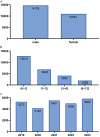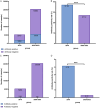Epidemiologic characteristics of immunoglobulin M antibodies in lower respiratory tract infection pathogens of children: association with severe pneumonia in Chengdu city from 2019 to 2023
- PMID: 40821038
- PMCID: PMC12351617
- DOI: 10.62347/BBXL3592
Epidemiologic characteristics of immunoglobulin M antibodies in lower respiratory tract infection pathogens of children: association with severe pneumonia in Chengdu city from 2019 to 2023
Abstract
Objective: To analyze the epidemiologic characteristics of serum immunoglobulin M (IgM) antibody aming six pathogens in children with acute lower respiratory tract infections (LRTI) and its association with severe pneumonia, thereby providing a basis for clinical diagnosis and treatment.
Methods: A total of 25,693 children with lower respiratory tract infections who were hospitalized in the Department of Respiratory Medicine at Chengdu Women's and Children's Central Hospital from 2019 to 2023 were included and retrospectively analyzed in the study. The epidemiologic characteristics of serum IgM antibodies for six LRTI pathogens in the enrolled children were analyzed. Logistic regression analysis was conducted to identify risk factors for severe pneumonia.
Results: The IgM positive detection rate among the six pathogens was 30.26%. In addition, the IgM positive detention rates among Mycoplasma pneumoniae (MP), Parainfluenza virus (PVI) and Influenza B virus (IFV-B) of female children were higher than those of male children (P < 0.05); Children who were younger than 1 year oldshowed the lowest IgM positive detention rates of MP and IFV-B (P < 0.05). The positivity rates of IgM antibodies for MP, IFV-B, PIV, and Respiratory syncytial virus (RSV) markedly varied across different lower respiratory tract infections (P < 0.001; P = 0.007; P = 0.004; P < 0.001). The IgM positive detection rate of two or more pathogens before COVID-19 pandemic were higher in comparison to those post COVID-19 (P < 0.05). Compared to the non-severe group, children with severe pneumonia showed a relatively lower detection rate of MP but a significantly higher detection rate of RSV. The results of multiple logistic regression analysis suggested that age and gender were independent influencing factors for severe pneumonia, with an area under the Receiver Operating Characteristics curve of 0.727.
Conclusion: In Chengdu city, the positivity rates of IgM antibodies for LRTI pathogens in children exhibited seasonal, age-related, and diagnostic category characteristics-related variations. Severe pneumonia cases were characterized by RSV infection and younger age. Clinicians should take epidemiologic features into consideration to optimize their diagnostic and therapeutic strategies.
Keywords: Children; IgM antibodies; lower respiratory tract infection; pathogens; severe pneumonia.
AJTR Copyright © 2025.
Conflict of interest statement
None.
Figures






Similar articles
-
Antibody tests for identification of current and past infection with SARS-CoV-2.Cochrane Database Syst Rev. 2022 Nov 17;11(11):CD013652. doi: 10.1002/14651858.CD013652.pub2. Cochrane Database Syst Rev. 2022. PMID: 36394900 Free PMC article.
-
Dynamics of respiratory virus transmission in children during and after COVID-19 outbreak control in Baiyin, China.BMC Infect Dis. 2025 Jul 7;25(1):901. doi: 10.1186/s12879-025-11285-8. BMC Infect Dis. 2025. PMID: 40624459 Free PMC article.
-
Epidemiological association of the COVID-19 pandemic on Mycoplasma pneumoniae infections in children in Tianjin, China: a single-centre retrospective study (2017-2024).BMJ Open. 2025 Jun 17;15(6):e101045. doi: 10.1136/bmjopen-2025-101045. BMJ Open. 2025. PMID: 40527576 Free PMC article.
-
A systematic review of compliance with palivizumab administration for RSV immunoprophylaxis.J Manag Care Pharm. 2010 Jan-Feb;16(1):46-58. doi: 10.18553/jmcp.2010.16.1.46. J Manag Care Pharm. 2010. PMID: 20131495 Free PMC article.
-
Changes in Mycoplasma pneumoniae epidemiological and clinical features in children before, during, and after the COVID-19 pandemic in Shanghai, China.Microbiol Spectr. 2025 Sep 2;13(9):e0288824. doi: 10.1128/spectrum.02888-24. Epub 2025 Aug 7. Microbiol Spectr. 2025. PMID: 40772744 Free PMC article.
References
-
- Li Y, Wang X, Blau DM, Caballero MT, Feikin DR, Gill CJ, Madhi SA, Omer SB, Simões EAF, Campbell H, Pariente AB, Bardach D, Bassat Q, Casalegno JS, Chakhunashvili G, Crawford N, Danilenko D, Do LAH, Echavarria M, Gentile A, Gordon A, Heikkinen T, Huang QS, Jullien S, Krishnan A, Lopez EL, Markić J, Mira-Iglesias A, Moore HC, Moyes J, Mwananyanda L, Nokes DJ, Noordeen F, Obodai E, Palani N, Romero C, Salimi V, Satav A, Seo E, Shchomak Z, Singleton R, Stolyarov K, Stoszek SK, von Gottberg A, Wurzel D, Yoshida LM, Yung CF, Zar HJ Respiratory Virus Global Epidemiology Network; Nair H RESCEU investigators. Global, regional, and national disease burden estimates of acute lower respiratory infections due to respiratory syncytial virus in children younger than 5 years in 2019: a systematic analysis. Lancet. 2022;399:2047–2064. - PMC - PubMed
-
- Wei M, Li S, Lu X, Hu K, Li Z, Li M. Changing respiratory pathogens infection patterns after COVID-19 pandemic in Shanghai, China. J Med Virol. 2024;96:e29616. - PubMed
-
- Song LX, Zeng HW. Analysis of common viral infections in patients with respiratory tract infections in zigong fourth people’s hospital from 2016 to 2019. Pract J Clin Med. 2021;18:126–129.
-
- Wang ZJ, Fang J, Hu XL, Hou XH, Xie YF, Zhu J, Ma YC, Zhuang Q. Pathogen and epidemiological characteristics of atypical pneumonia in children. Pract J Clin Med. 2020;17:156–158.
LinkOut - more resources
Full Text Sources
